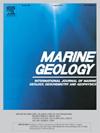贝叶斯统计分析揭示了印度东南部泰恩旋风沉积物的空间异质性
IF 2.2
3区 地球科学
Q2 GEOSCIENCES, MULTIDISCIPLINARY
引用次数: 0
摘要
保存在硅质海岸线上的风暴沉积物的现代地质记录是评估风暴过去和现在的规模和影响的重要档案。我们从印度东南部泰米尔纳德邦沿海地区 6 个地点的 14 个坑中研究了 2011 年 12 月 31 日 "泰恩旋风 "的地层和沉积特征以及下伏的沿海单元。我们对每个矿床的粒度参数、粒形和重矿物比例进行了高分辨率分析,并研究了每个单元的沉积结构。我们首次使用贝叶斯因子来定量评估风暴沉积沉积与其他同位海岸沉积沉积之间的异同。在一些地点,风暴沉积与下伏沿岸沉积在一些参数上存在差异,但在一些地点,则无法区分不同的沉积单元。在对不同地点的风暴沉积进行比较时,平均粒径的变化规律最为一致,位置较近的地 点平均粒径相近,而位置较南的地点粒径较细。其他测量参数显示的一致性要差得多,相邻地点的差异往往大于较远地点的差异,这证明沉积物沉积过程中存在非常局部的水动力变化。与沉积参数一样,每个地点保存的沉积物沉积过程中形成的沉积结构也存在很大差异。迄今为止,冲积扇向陆边缘的末端前缘仍是风暴沉积的唯一特征,但这一特征并非在所有风暴沉积中都普遍存在。我们的研究结果表明了风暴沉积物沉积在空间上的异质性,以及在沿岸硅质岩序列中 识别风暴沉积物所面临的挑战。贝叶斯统计方法的使用也为评估和区分沿岸沉积物提供了一种稳健的方法,与传统的 频数统计方法相比具有许多优势。这种方法很容易应用于其它沉积沉积环境。本文章由计算机程序翻译,如有差异,请以英文原文为准。
Bayesian statistical analysis reveals spatial heterogeneity in Cyclone Thane deposits from Southeast India
Modern and geological records of storm sedimentary deposits preserved on siliciclastic coastlines are important archives to evaluate the past and current magnitude and impacts of storms. Examination of modern storm deposits also offers the opportunity to evaluate the similarities and differences between storm and other coastal overwash processes and hazards.
We examined the stratigraphy and sedimentary characteristics of the 31st December 2011 Cyclone Thane and underlying coastal units from 14 pits from six sites from the coastal zone of Tamil Nadu Province, southeast India. We analysed the grain size parameters, grain shape, and heavy mineral proportions of each deposit in high resolution and examined the sedimentary structures of each unit. For the first time, we use Bayesian factors to quantitatively evaluate the similarities and differences between the storm sedimentary deposits and other co-located coastal sedimentary deposits. At several sites, the storm deposits differ in several parameters from the underlying coastal deposits, but at some locations, distinguishing between different depositional units cannot be achieved. In comparing the storm deposits from the different sites, mean grain size results in the most coherent pattern with closely located sites having similar mean grain size, and more southerly sites being finer grained. The other measured parameters show a far less coherent pattern with adjacent sites often preserving larger differences than more distal sites attesting to very local hydrodynamic variations during sediment deposition. As with the sedimentary parameters, the sedimentary structures formed during sediment deposition preserved at each site are highly variable. To date, the presence of terminal foresets at the landward edge of washover fans remains the only diagnostic feature of storm deposition, but that this feature is not ubiquitous across all storm deposits. Our findings demonstrate the spatially heterogeneous nature of storm sediment deposition and the challenges of identifying storm deposits in coastal siliciclastic sequences. The use of Bayesian statistical approaches also offers a robust method for evaluating and discriminating between coastal sediment deposits that has many advantages over traditional frequentist approaches. This method can easily be applied to other sedimentary depositional environments.
求助全文
通过发布文献求助,成功后即可免费获取论文全文。
去求助
来源期刊

Marine Geology
地学-地球科学综合
CiteScore
6.10
自引率
6.90%
发文量
175
审稿时长
21.9 weeks
期刊介绍:
Marine Geology is the premier international journal on marine geological processes in the broadest sense. We seek papers that are comprehensive, interdisciplinary and synthetic that will be lasting contributions to the field. Although most papers are based on regional studies, they must demonstrate new findings of international significance. We accept papers on subjects as diverse as seafloor hydrothermal systems, beach dynamics, early diagenesis, microbiological studies in sediments, palaeoclimate studies and geophysical studies of the seabed. We encourage papers that address emerging new fields, for example the influence of anthropogenic processes on coastal/marine geology and coastal/marine geoarchaeology. We insist that the papers are concerned with the marine realm and that they deal with geology: with rocks, sediments, and physical and chemical processes affecting them. Papers should address scientific hypotheses: highly descriptive data compilations or papers that deal only with marine management and risk assessment should be submitted to other journals. Papers on laboratory or modelling studies must demonstrate direct relevance to marine processes or deposits. The primary criteria for acceptance of papers is that the science is of high quality, novel, significant, and of broad international interest.
 求助内容:
求助内容: 应助结果提醒方式:
应助结果提醒方式:


